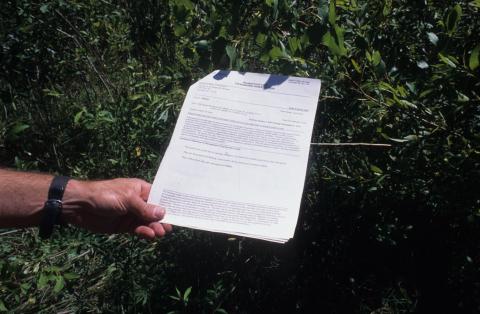I recently I took down the 2017 calendar, and hung up the 2018. It’s actually a really beautiful calendar of Wisconsin natural features. Along with those calendars came some work planning for the year. Funny enough, it turns out that my blog topic for the month is on management plans. The timing for this topic couldn’t be better. For those of you that have a management plan already, pull it off the shelf and start the preparations for what you had planned for this year. For those of you who don’t, read on.
There are many reasons to have a written management plan for your woodlands. Most simply, a plan is a place to keep track of past and future projects for your property including timelines and tasks. The plan is also a place to write down your goals and intentions for the property, both for yourself and to communicate this with future owners. Plans can cover 5 years to 50 years, so it is also a great record of the history of the property. And, as tax season is upon us, it serves as business records as well for deductible expenses and to prove that you are an active manager. (For more information on this, check out the Timber Tax Tips for 2017 at timbertax.org.)
The term “management plan” is used quite frequently, but the end product is very different from person to person and woodland to woodland. Start by asking how a plan would serve you and your interests. Do you need a specific plan for a short-term project, or a broad plan that covers your entire property? For example, if you want to plant trees on a parcel of your property, you can write up a planting plan that might address simple things like the location, number of acres, goals, activities, timeline, and costs. However, if you want to address wildlife or recreation opportunities on your entire property, then a general stewardship plan would be appropriate. If you are interested in taking advantage of the tax law program, cost-share programs or certification, you may need a more detailed plan that addresses the requirements for that program.
- A project plan is pretty self-explanatory; everything necessary to that specific project should be included in that document. These plans might cover 1-5 years; the life span of the project. The WI DNR has a tree planting plan template on their website (http://dnr.wi.gov/topic/TreePlanting/plan.html) that will give you an idea of what a project plan might look like. Generally, you would use something like this for a specific project in a specific place on your property. Other cases where you would want a project plan might be a specific wildlife habitat project, a stream protection project, invasive species control, or a small timber sale.
- A basic stewardship plan encompasses the entire property, spanning a longer period of time, at least 10 years. Again, a stewardship plan will vary by landowner and woodland. The most basic form of this might be a letter you would get from a forester after a walk-through on your property. This might be as simple as a description of the various areas within your entire woodland, some ideas of specific action you can take based on your own interests, and some names and publications on how to get started. If you think you want to try your own hand at a management plan, check out My Land Plan (https://mylandplan.org/why-sign). That site will guide you through some of the steps to start this, and has access to some resources you might needs (eg. aerial photos).
- The next step is a full management plan. A forester will take the time to inventory your entire woods and help you plan for a longer horizon based on what the forest is likely to do and what you want it to do. This plan would take an even broader look at your woods from the trees, the health of your woods, wildlife (current and future potential), and how you want to enjoy it. The outline of activities will be specific, similar to a project plan, but will approach those projects in regards to the longer timeline and in perspective of your woods as a whole.
- If you are interested in entering the tax law program (Managed Forest Law- MFL), taking part in any certifications systems (such as Tree Farm), or interested in cost-share programs, they will require you to have a management plan, and may require specific information be included. Generally, these fit the description of a more detailed stewardship plan. The time frame for these, in particular the MFL program, will be 25 or 50 years. The MFL program and Tree Farm require certain formats for the management plans, and require that a certified forester write the plans, so if you may be interested in these in the future, take note of those requirements when you are talking to foresters.
The concept of a management plan may seem overwhelming, but don’t let this get in the way of your starting one. Take the first step, and check out the DNR tree planting plan and this sample management plan. Then maybe take a look at the My Land Plan website, and start thinking about how you would get the best use from a management plan. The last step would be to meet with a forester; check out a previous blog post on what to expect when you meet with a forester. Good luck and happy New Year playing in your woods.
